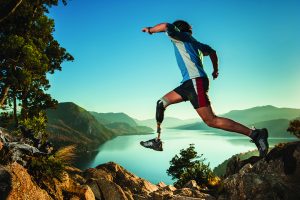×


We have detected your country as:
Please click here to go to the USA website or select another country from the dropdown list.

Photo: ericsmandes/ Shutterstock.com
Ill-fitting joint sockets, contact dermatitis and sebaceous cysts are just a few of the problems plaguing prosthetic patients. They result from pressure that prosthetic devices place on the soft tissue of their bodies.
Researchers at Tel Aviv University (TAU), FOM Institute AMOLF and Leiden University have developed a new approach to manufacturing mechanical “metamaterials”—synthetic composite materials with structures and properties not usually found in natural materials—that can be programmed to deform in a uniquely complex manner. The breakthrough may lead to more close-fitting, comfortable and user-friendly prosthetics.
Dr. Yair Shokef of TAU’s School of Mechanical Engineering and Prof. Martin van Hecke of Leiden University and AMOLF, the Netherlands, illustrated their approach through a three-dimensional printing of a metamaterial cube. “We started with a series of flexible building blocks or bricks that had deformation properties that varied with their position,” said Dr. Shokef. “The blocks were able to change their shape when we applied pressure.”
The metamaterial has the unusual property that spatially-patterned compression in one direction leads to predictable, spatially-patterned deformation (dents and protrusions) in other directions.

Photo: english.tau.ac.il
“A pattern of specific bulges appears when our seemingly normal cube is compressed,” said Dr. Shokef. “Using metamaterials, we can ‘program’ the material’s behavior by carefully designing its spatial structure.”
There are many applications on the horizon for this new basic research. “This type of programmable ‘machine material’ could be ideal for prostheses or wearable technology in which a close fit with the body is important,” Dr. Shokef said. “If we can make the building blocks even more complex or produce these from other materials, the possibilities really are endless.”
Source: Excerpt of press article published by American Friends of Tel-Aviv University
All logos and trademarks in this site are property of their respective owner. All other materials are property of Bridges for Peace. Copyright © 2024.
Website Site Design by J-Town Internet Services Ltd. - Based in Jerusalem and Serving the World.